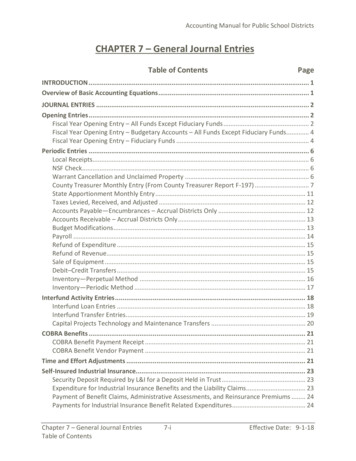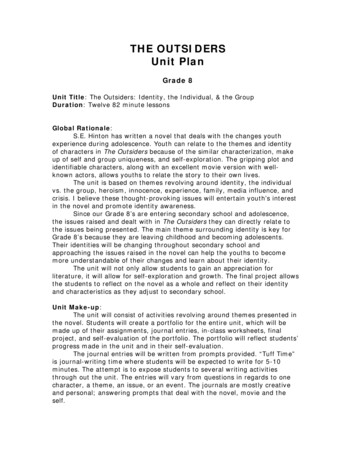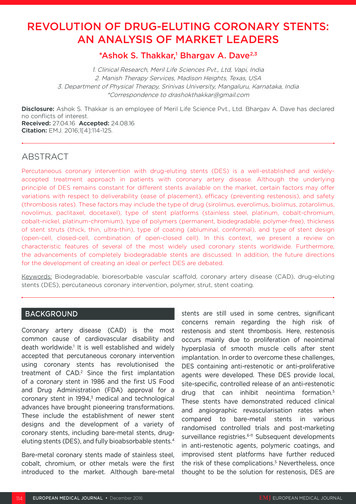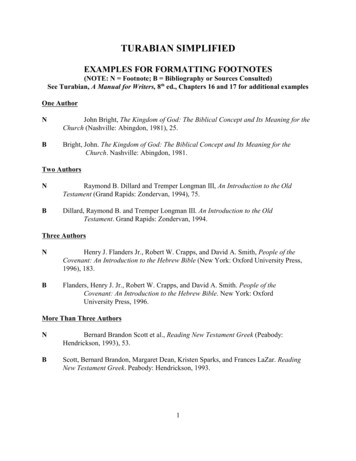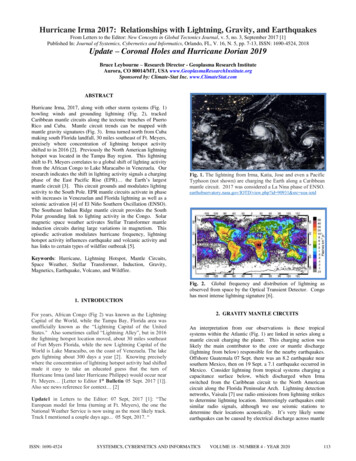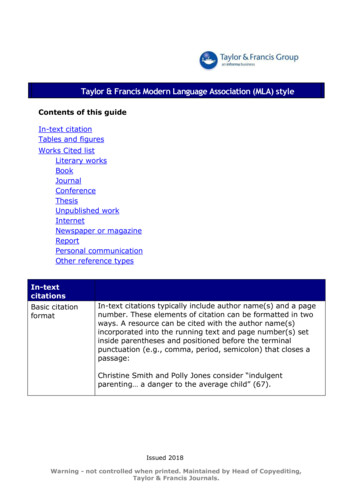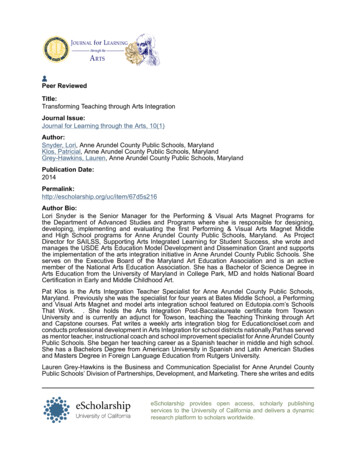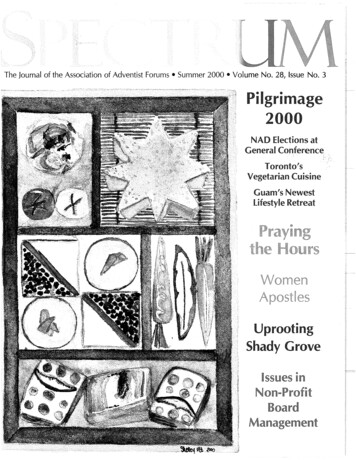
Transcription
The Journal of the Association of Adventist Forums Summer 2000 Volume No. 28, Issue No. 3Pilgrimage2000NAD Elections atGeneral Conference .:;Toronto'sVegetarian CuisineGuam's Newestlifestyle RetreatUprootingShady GroveIssues inNon. . rofitBoardManagement."
SPECTitUMEditorAssistant Editor, Design and LayoutBook Review EditorTechnical EditorPromotions and CirculationSPECTRUM is a journalBonnie DwyerSharon Fujimoto-johnsonGary ChartierLeigh johnsenPhilipa Barnesestablished to encourage Seventhday Adventist participation in thediscussion of contemporary issuesfrom a Christian viewpoint, to lookBeverly BeemRoy BentonEdna Maye LovelessEnglish, ChairWalla Walla CollegeMathematical SciencesColumbia Union CollegeEnglishLa Sierra UniversityRoy Bransonjoy Cassano ColemanEdward LugenbealCenter for Law and Public PolicyColumbia Union CollegeFreelance WriterFederalsburg, MarylandAnthropologyAtlantic Union CollegeAlita ByrdGene DaffernDonald R. McAdamsWriterTakoma Park, MarylandPhysicianFrederick, MarylandPresidentMcAdams, Faillace, and Assoc.Chip CassanoTom DybdahlBenjamin ReavesWriter/EditorUniversity of MarylandAttorneyPhiladelphia, PennsylvaniaAdventist Health SystemOrlando, FloridaBonnie DwyerKaren BottomleyRennie SchoepflinjournalistGranite Bay, CaliforniaDean of ArtsCanadian University CollegeHistory, ChairLa Sierra UniversitySharon Fujimoto-johnsonRaymond CottrellGerhard Svrcek-SeilerWriter/Graphic DesignerSacramento, CaliforniaTheologyLorna Linda, CaliforniaPsychiatristVienna, AustriaFritz GuyClark DavisHelen Ward ThompsonTheologyLa Sierra UniversityHistoryLa Sierra UniversityEducational AdministrationCollege Place, Washingtonjuli MillerLawrence GeratyLouis VendenMarketing Communication ConsultantElDorado Hills, CaliforniaPresidentLa Sierra UniversityReligionLorna Linda UniversityRichard RiceGary LandNorman YoungTheologyLorna Linda UniversityHistory, ChairAndrews UniversityNew TestamentAvondale CollegeCharles ScrivenDavid LarsonPresidentColumbia Union CollegeFaculty of ReligionLorna Linda Universitywithout prejudice at all sides of asubject, to evaluate the merits ofdiverse views, and to fosterChristian intellectual and culturalgrowth. Although effort is made toensure accurate scholarship anddiscriminatingjudgment, thestatements of fact are the responsibility of contributors, and the viewsindividual authors express are notnecessarily those of the editorialstaff as a whole or as individuals.SPECTRUM is published by the.,Association of Adventist Forums, anonsubsidized, nonprofit organization for which gifts are deductible inthe report of income'for purposesof taxation. The publishing ofSPECTRUM depends on subscriptions, gifts from individuals, andthe voluntary efforts of theAll Rights Reserved Copyright 2000 Association of Adventist ForumsAbout the CoverVegetarian cuisine has moved to a new level. Truly extraordinary vegetarian restaurants arebeginning to appear and win high praise in selected cities such as Seattle and San Francisco.Restaurants like Carmelita and Millennium have become choice destinations for people who loveinteresting food and beautiful presentation. Sometimes a gourmet meal can be a pilgrimage.Carmelita, in Seattle, serves a seasonal vegan and vegetarian menu influenced by foods andflavors from around the Mediterranean. Chef Jonathan Sundstrom has taken the owner's artisticaspirations to heart, designing dramatic meal presentations and underescoring the vitality ofvegetarian cuisine.When Millennium opened in 1994 in San Francisco, chef Eric Tucker wanted to reinventvegetarian cuisine "so that people perceived it as a path to a better and happier life, not just apolitical statement or monastic solution to our collective culinary guilt." He did so by preparingdishes that appeal to all the senses with excellent presentation, as well as with fresh ingredients.Influenced by the flavors and styles of many cultures, he drew on the health principles of pioneerslike John McDougall and Dean Ornish.Carmelita: (206) 706-7703Millennium: (415) 487-9800About the ArtistShelley Utt is a wandering poet, artist, and professional odd-jobist who graduated in 1998from Charles Wright Academy in Tacoma, Washington.contributors.Editorial CorrespondenceDirect all correspondence andletters to the editor to:SPECTRUMP. 0. Box 619047Roseville, CA 95661-9047TEL: (916) 774-1080FAX: (916) 791-4938editor@spectrummagazine.org(Letters to the editor may be editedfor publication.)
SrECTR UMSummer 2000 Volume No. 28, Issue No. 3Prayer and Bible Study4Praying the Hours: The Benedictine WayBy Beverly BeemLearning to listen to what God has to say at this moment.10What the Church Today Can Learn fromthe Book of ActsBy Sakae KuboLiberals and conservatives debate evangelistic methods inthe ancient world.17Shapes of Ministry in the New Testamentand Early ChurchBy Robert M. JohnstonIntroducing Junia and Phoebe, two women apostles ofthe early church.Women in Ministry25Landmarks in Women's Ministry Since UtrechtEleven women have been ordained in North America since 1995.28Refocusing the Ordination Discussionas a Local IssueBy Georgia E. HodgkinThe Southeastern California Conference votes to treatmen and women pastors equally.32Southeastern California ConferenceOrdination-Commission ProceduresOutlining the role of conference and congregation inordination-commission.35Four Reasons Why Women's Ordinationis a Moot IssueBy Sakae KuboWhy quibble about ordination since women serve as ministers?
Pilgrimage 200038Exploring Toronto's Vegetarian PalateBy Jaelene M. MannerfeldtWith forty vegetarian restaurants, Toronto is ready for GeneralConference and the World Vegetarian Congress that follows.40The Toronto Pilgrimage Beyond the SkyDomeBy Richard BottomleyDiscovering Biblical history lessons, a music garden, and the shoemuseum in Toronto.44Presidential Prospects for the North AmericanDivisionBy Doug MorganWhat the changes in delegate selection will mean to the election ofa North American Division president.48There and Back and In-betweenBy John R. JonesClaiming the liminality and the communitas of pilgrimage.54life-Altering VacationsBy Sharon Fujimoto-JohnsonGetting healthy and a tan in Guam.Institutional Change58Beyond Dull Meetings and Dessert: ImprovingNon-profit BoardsBy Juli Miller and Scott OrmerodEffective governance by a nonprofit board is a rare andunnatural act.64Uprooting Shady GroveBy Alita ByrdA Maryland Adventist hospital battles the Washington Post andthe hospital accrediting agencies.74lettersEditorials and AAF Information3More than Yada, Yada, YadaBy Bonnie Dwyer79Anxiety about Salvation: Causes and CuresBy David R. Larson78How to Subscribe to80Information about the Association of Adventist Forums2 SPECTRUM Volume 28, Issue 3 Summer 2000SPECTRUM
fROMTHEEDITORMore than Yada, Yada, YadaFor a magazine editor, there is no greater pleasurethan to see the discussion begun within one's pagesacknowledged and continued elsewhere. So it givesme great pleasure to tell you that the John Templeton Foundationhas awarded a prize to Richard Rice for his article, "The Scientist asBeliever," which appeared in the spring 1999 issue of Spectrum (vol. 27, no. 2).Another article that has received a great deal of attention is the one byReinder Bruinsma, ''Adventists and Catholics: Prophetic Preview or Prejudice," inthe summer 1999 issue (vol. 27, no. 3). Bruinsma's article has sparked a vigorous discussion of Catholicism and the Antichrist in other Adventisfpublications: Adventist Review, OurFirm Foundation, and Quo Vadis have all weighed in with responses. Obviously this is a topic ofgreat concern to the Adventist community, one that deserves more discussion. Perhaps ourunderstanding of the Antichrist can be expanded through our conversation.With this issue we consider another topic that has touched off volatile debates at the lasttwo General Conference sessions: the ordination of women. The topic is not on the agenda thisyear. And that's not all bad. Sakae Kubo suggests it is a moot point (pages 35-37). The action ofthe Southeastern California Conference (pages '28-34) demonstrates a concrete way for action toreplace debate on this topic.Simply allowing local and union conferences to do the task that they were created to do isenough. Then the General Conference president could praise conferences, such as SoutheasternCalifornia, for aligning their policies with the biblical principle of equalityPerhaps this year as we make a community pilgrimage to Toronto, the Canadian attitudeof "live-and-let-live" (pages 40-43) will rub off on us, take the edge off of our conversations,and allow us to enjoy the time together as a church family. Maybe voted actions are not thepoint of this General Conference session. Maybe just coming together is what we need, sharingprayers and meals and listening to each other--as Beverly Beem points out (pages 4-9).Perhaps the lessons presented from the book of Acts (pages 10-16), or the issues that facethe boards of our organizations (pages 58-73), will catch the imagination of our family andspark continuing conversations.Are we ready to listen to each other? That's the important question this year.Bonnie DwyerEditorEDITORIAL 3
by Beverly Beemn ancient monastic story tells about a young monk who cameto a teacher who was busy working and praying with agroup of people. The monk said, "Since I can walk on water, let'sgo off alone onto the lake and enjoy some elevated spiritual conversation."The teacher replied, "If you simply want to avoid all these people, why don't you comefly away with me and we can drift along the clouds together." The young monk said, "Ican't. I don't know how to fly." The teacher replied, "Neither can I walk on water. These are thethings that any bird or fish can do, but they have little to do with the spiritual life. If you want to talk aboutthat, we should stay right here." 1I went to a Benedictine monastery to live the spiritual life more intently. The monks sent me home to liveit where I am. That is the point of this story. That is the Benedictine way. The writings of Kathleen Norris,particularly Cloister Walk, have helped create popular interest in the monastic life as something available toordinary people. 2 Other writers, such as Thomas Merton and Henri Nouwen, have drawn attention to the valueof solitude and silence for people caught up in the demands of family and work. The Chant CD by theBenedictine Monks of Santo Domingo de Silos has introduced listeners to the haunting beauty of monastic4 SPECTRUM Volume 28, Issue 3 Summer 2000
music, and the music of Hildegard of Bingen, thetwelfth-century nun, has helped awaken interest in thesaints and mystics of the Church. Regional guides tosanctuaries and retreat houses have guided pilgrims,tourists, seekers, and the merely curious to the hospitality of the monks and nuns. 3 If any visitors go withromantic visions of pious folk in robes gliding effortlessly around the cloister, feet two inches off theground, they are in for a surprise. Though I foundDoes St. Benedict have anything to say to me today? 5A major disillusionment for my own cloisterwalk was finding no cloister. The building is a duderanch turned monastery, fitting the needs of thecommunity but lacking the Gothic arches. The chapelis a converted rec room with an electronic keyboard.But the Benedictine way is not dependent on movieset architecture. Worship does not need soundtrackaccompaniment. Rather, we walked out the back doorto the Pecos River and twelvehundred acres of the high desertcountry of New Mexico. Miles"My experience of the Benedictine way wasof trails provided our cloisterwalk; desert skies sheltered ourlearning to listen. Listen to God. Listen to thesolitude. Here the adobe buildings and southwestern architeccommunity. Listen to Scripture. Listen toture fit naturally to the place, itssolar heating kind to the envieach other. Listen to your own heart."ronment. This, too, is theBenedictine way.pious souls during my month-long stay at the Pecos"How are you doing?" Sister Ruth, the head ofthe women's community, asked me in a dinner tableBenedictine Monastery, their feet were planted firmlyon the ground. This is the Benedictine way. Whereasconversation. We had been talking, and I found thatother monastic orders have come and gone, meetingshe had some Adventism in her own family heritage.the particular needs of their times, the BenedictineShe might understand better than most some of theway has retained its influence since the fifth century. It culture shock I was feeling.has staying power. I wanted to see for myself what it"To be honest," I told her, "I am struggling tohas to offer its community and its guests who come tohang on to the worship services. Not knowing thevisit.words of the songs or the prayers, I find myselfI went to this place for three reasons. First, Ifumbling through the hymnal, trying to keep up, neverquite in the right place. So for much of the time I findwanted to study spiritual direction, and the Pecoscommunity has offered a School for Spiritual Directors myself just listening."since 1977, bringing together people from all denomi"Ah," she said, "that is the basis of the Benedictinenations as teachers and participants. Second, I wantedrule. The first word in the Rule is 'Listen."'to deepen my own prayer life, learning what the giftsIt requires a new way of learning for visuallyof solitude and silence could teach me. Third, Ioriented people like me. But this is the Benedictinewanted to understand the Benedictine life from theway. Quiet the anxiety to do it right and just listen.inside out.Listen to what God is saying to you at this moment.My previous acquaintance with the BenedictinesMy experience of the Benedictine way washad been largely through my study of literature andlearning to listen. Listen to God. Listen to the community. Listen to Scripture. Listen to each other.church history. Most particularly, The Rule if St.Benedict provides a key to understanding the thoughtListen to your own heart. Listen to the work of theof the Middle Ages and much of the history of themoment. Listen to the world around us. That God isChurch. · Benedict of Nursia (480-547) was educatedpresent in our lives and actively speaking to us is ain the worldly wisdom of Rome, but he turned hisfundamental premise of the Benedictine way. It is ourback on its wealth and power in a single-mindedtask to listen. The Benedictine life is designed tosearch for God. His handbook, commonly referred tocultivate a life of listening.as the Rule, has principles applicable in and out of theThis listening takes place largely through Scripmonastic community and has become a guide forture and the liturgy. The primary purpose of theBenedictine community is to do the work of God, theanyone who seeks an intimate connection with God.Yet his Rule seems too much of a cultural artifact.Opus Dei. Prayer and praise is the great priority for thePRAYER AND BIBLE STUDY 5
Benedictine life. "Nothing is to be preferred to the work to-do lists and the noise and clutter within us. Sittingof God," says St. Benedict. The Opus Dei, the work of in the darkness, we learn to be still and listen. I thinkGod, is what we do whenever we enter the chapel to of Jesus rising a great while before day. I think ofpray, to sing the psalms, to hear the Scriptures. The pro- Father Sam praying at 3:00 a.m. I think how hard it iscess of lectio divina, reading the Scriptures not just for for me to haul myself out of bed before light. Butinformation, but to hear what God is saying to us in our doing so adds a whole new dimension to the day. Thetime and place, is one of the gifts of the Benedictine spirit of Vigils teaches us to trust the dark and watchcommunity. Singing the psalms is a part of every wor- for the light.We greet the light at Lauds, the morning serviceship, steeping us in Scripture and connecting us withthe whole range of human experience expressed in the at dawn. We begin the hour in darkness and end it inlight. We watch the day coming through the windows.psalms, praise and lament alike.From the Benedictine Abbeya stream of praise is always flowing, and this liturgy of the hours"Silence is the backdrop to the day as whiteprovides the structure and purposeof the day as the seasons do theyear. At the transitional hours of space is to the words on a page. Silence clearsthe day, the change from darknessaway the clutter and noise that often gets in theto light, from morning to afternoon, from day to night, fromway of our communion with God."wakefulness to sleep, we pull awayfrom the demands of the momentto pray. When we go into thechapel to hear the word and sing the psalms, we are Never taking it for granted as just another sunrise, wegoing to let the Opus Dei do its work in us. We are go- receive the day as the gift of God. The Benedictinespirit is the spirit of awareness and gratitude, awareing to listen, to hear, and to sing.6ness of God's grace and power in the ordinary eventsThe hours begin with Vigils, the night watch. Iof the day and gratitude for his presence. Those whoasked Father Sam, who calls himself "a beat-up oldmonk," when he found time for his personal devotions. take such things for granted will never see the light'1\round 3:00 o'clock," he said. Further along in thecoming in through the windows.If the hymns, prayers, and scripture of theconversation I realized he meant 3:00 a.m. He spendsliturgy are an essential part of the Benedictine day, soan hour in devotions.is silence. Silence is the backdrop to the day as white"Then do you go back to bed before the risingspace is to the words on a page. Silence clears away thebell at 5:30?" I asked.clutter and noise that often gets in the way of our"No, I play computer games."communion with God. This rule of silence is occaI think St. Benedict would like that. He didn'tcall it Vigils, but that's what it is. Why start the day in sional rather than total. In Pecos, breakfasts are takenin silence. Silence in the morning is an ancient monasthe dark? The darkness hides the furnishings of ourlives. It is a time of mystery, the darkness out oftic tradition, so the word of God can continue tospeak. Moving from the spiritual feast of the liturgy towhich light comes. If light is a symbol of God, so isdarkness, "a deep, but dazzling darkness." 7 The Gospel the physical one, we allow the Word of God we havejust heard take root in the mind for the day. Afterof John starts with the Light that shines in darkness,hearing, the heart continues to listen in silence.not the light that "shines into the darkness, like aThe monastery provides a place to get away fromflashlight shining into a dark tent." Rather, it is the8of many words, an adjustment for those ofthenoiselight that "shines right in the midst of darkness."us addicted to hourly news updates. One local newsThe challenge of the hour is to look deeply enoughpaper appears in the coffee room, and a TV withinto the darkness to find God.modest reception occupies a corner of the guestBut Vigils is also a time of waking up. Thislounge along with two pay phones to provide minimalwatching and waiting prepares us for the appearancecontact with the outside world. But silence is moreof a larger reality. With the darkness around us wethan the absence of noise. It comes from within. Ilearn to listen. We are not distracted by our multiple6 SPECTRUM Volume 28, Issue 3 Summer 2000
pause, "the monastic coffee break." The focus offound it takes a while for the noise inside to dieprayer is the work at hand. Sext is the hour ofdown. Even in the monastery, it takes some effort topush aside the business of the day and claim theproductivity and the hour of lethargy. High noon.offerings of silence and solitude. The attempt to liveThe turning point in the day. Time of transition.in silence at the monastery reinforced for me the need Time for prayer. None, or mid-afternoon, moves usfor silence in my life at home. I really shouldn't havetoward the end of the working day, a time to putour work in perspective.to go to a monastery to find silence, yet I havebecome accustomed to living with noise. The carA working community does not stop at each ofthese hours to gather into the chapel but acknowledgesradio and the TV provide background noise to myday, and I learn not to pay attention. If I am to findthe passing hours while at work, whether in the library,silence in my day, I have to plan for it. Learning tothe shop, the field, or the kitchen. At Pecos, we combineput silence in our lives is one of the gifts the monasall these Little Hours into one noonday prayer. We stopat the turning point of the day for a moment of prayertery sent home with us.Praying the hours is one way to claim thisand singing. I learn from this the value of fragmentsof time. It doesn't take long to pause for worship, tensilence. Between the major hours of Lauds in theminutes at the most, and soon I naturally turn to themorning and Vespers in the evening are the LittleHours of the workday. Rather than barreling throughchapel at noon. Before the community of the noondaythe day, we acknowledge the passing hours and stop, if meal is the community of noonday worship. Our workonly for a moment, to pray. Prime, the early morningmay be solitary, but noonday is a time to rememberhour, is a time of planning the day and praying forthat we are not alone. We are in community. We areloved. We see our work in context. The bell that calls usGod's blessing, making the work itself a prayer. Thisis the hour for getting your priorities straight andto worship reminds us that we are living our lives inputting them all before God. Terce is the mid-morning the presence of God-and to look up.PRAYER AND BIBLE STUDY 7
Work is a part of the balanced life of theBenedictine way, an essential part of the monasticday Historically, the work of monasteries was in thescriptorium, the work of copying ancient texts,particularly the Gospels. Some monasteries continuethis tradition, many with electronic resources, updating an ancient tradition. Others work at all kinds oftrades and industries-keeping bees, baking bread,printing, farming, whatever trade the environment andtalents allow.For the Benedictine community, much of itswork revolves around the gift of hospitality That,too, is an essential part of the Benedictine life.Providing hospitality to guests is part of thecommunity's mission. Community members do muchof the work themselves, moving easily from thechapel to the kitchen. The quality of the meal mightdepend on which of the monks or nuns have kitchenduty that day The scholarly Father Michael often didthe dishes. An apron covering his habit, he took ourdishes off the bussing tray, rinsed them off, and putthem in the dishwasher, just like home. It was home.We were guests at their table, and the work ofhospitality is the Benedictine way, integrated with thelife of prayer. I happened to meet Sister Miriam inthe laundry room. She was surrounded by mountainsof guest linens, loading up the washers and foldingsheets from the dryer. I tried to commiserate, but8 SPECTRUM Volume 28, Issue 3 Summer 2000she would have none of it."I asked for this job," she said, "I can do it while I pray"I learned much about the spiritual life in thekitchen and the laundry room. That would not surprise my Benedictine hosts.The morning and evening services provide theframework for the day. In Vespers we leave behind thework of the day and come to worship, lighting thelamps for evening. It is a time of praise. The hymnsung is the "Magnificat," the joyful song of Mary, "Mysoul proclaims the greatness of the Lord, and myspirit exults in God my Savior."The conclusion of the monastic day is celebratedin Compline, the completing of the circle, a time ofself-examination and confession, moving us into thenight's rest. It begins with the prayer, ''A peacefulnight and a perfect end grant us." The hours teach ushow to live our days, and the end of the day promptsus to remember the end of our lives. The psalm sung isPsalms 91, praying for the shelter of God's protection.The day ends with an expression of faith in God'sprotection through The Great Silence, the timebetween Compline and Vigils, the ending of one day andthe beginning of the next.The Benedictine life blends work, worship,prayer, play, and hospitality into a life of balance.Every day has its hours appointed to the essentialsof life. Rather than doing nothing except work for a
week and then recovering in a day of play, thebalanced life devotes the proper time to all thenecessities of life. Every part of life has its propertime, and there is time enough for everything. It isalso a life of stability. Like other religious orders, theBenedictines have a ministry to the world, but theyexercise it at home. While others go out working andpreaching, they stay put. The vow of stability meansnity. I missed its songs and its prayers. I would beglad to get back home. I learned from theBenedictines much that will strengthen my ownwalk with God. They reminded me of some thingsmy own tradition tends to forget sometimes, but myown walk must take place in my own community St.Benedict would agree, I think.Notes and References"Every day has its hours appointed to theessentials of life. Rather than doing nothingexcept work for a week and then recovering ina day of play, the balanced life devotes theproper time to all the necessities of life."that they learn to find the voice of God in theirlives where they are. They are not tempted towander, looking for greener pastures. Disputes withcolleagues have to be worked out. There is no greatwork to do around the corner. They are called to dothe work at hand. At this time. In this place. Theirministry is to those who knock on their doors.Every guest is to be received as Christ.We received the Benedictine gift of hospitality.For a while we were invited into their community.We prayed together, sang together, worshipedtogether, ate together, shared our stories, andencouraged one another in our walk with God. Welived the model of the Christian community foundin 1 Thessalonians 5, praying constantly, buildingone another up. The monks and nuns of theBenedictine community are people seeking God, butthey do so in community. They pray togetherbecause they live together. The way of communionwith God is also the way of community with eachother.I remember the scene of the last day as wepiled into a bus for the ride to the airport. Wewould go our separate ways, rejoining our owncommunities. The Pecos community lined thedriveway waving us goodbye."What are you going to do when we leave?" weasked them."Get back to our prayers," they said.It is a beautiful community. I loved my staythere. But it was enough. I missed my own commu-1. Joan D. Chittister, WisdomDistilledfrom the Daily: Living theRule qf St. Benedict Today (SanFrancisco: HarperSanFrancisco,1990), 1-2.2. (NewBooks, 1996).York: Riverheads. Jack and Marcia Kelly,Sanctuaries: The Complete UnitedStates: A Guide to Lodgings inMonasteries, Abbeys, and Retreats (NewYork: Bell Tower, 1996). The same authors have alsopublished regional guides.4. The Rule qf St. Benedict, trans. Anthony C. Meiseland M. L. del Mastro (New York: Doubleday, 1975).5. The following books provide good introductions tothe Benedictine way: Elizabeth J. Canham, Heart Whispers:Benedictine Wisdom for Today (Nashville: Upper RoomBooks, 1999); Joan Chittister, The Rule qf Benedict: Insightfor the Ages (New York: Crossroad, 1992); M. BasilPennington, A Place Apart: Monastic Prayer and Practice forEveryone (Liguori, Mo.: Liguori/Triumph, 1998); CyprianSmith, The Path qf Life: Benedictine Spirituality for Monks &Lay People (York, Eng.: Ampleforth Abbey Press, 1995);Columba Stewart, Prayer and Community: The BenedictineTradition (Maryknoll, N.Y.: Orbis, 1998); Benet Tvedten, AShare in the Kingdom: A Commentary on the Rule qf St.Benedictfor Oblates (Collegeville, Minn.: Liturgical Press,1989); Esther de Waal, A Life-Giving Way: A Commentary onthe Rule qf St. Benedict (Collegeville, Minn.: LiturgicalPress,1995).6. A goodintroduction to the liturgical hours is in thecompanion to the Chant CD: David Steindl-Rast, The Musicqf Silence: Entering the Sacred Space qf Monastic Experience(New York: HarperSanFrancisco, 1995). Much of myunderstanding of the meaning of the hours comes fromthis book.7. Henry Vaughan, "The Night," 1655.8. Steindl-Rast, Music qf Silence, 25.Beverly Beem is professor of English and chair of theEnglish department at Walla Walla College. She holds aPh.D. in Renaissance literature from the University ofNebraska, Lincoln. She frequently conducts workshops,which she calls "Writing Our Way Home," aboutkeeping a spiritual journal.beembe@wwc.eduPRAYER. AND BIBLE STUDY 9
by Sakae Kubohe book of Acts is the story of a provincial church that became worldwide, a national church that became international. It is the story about a church searching for answers to newsituations that arose as it stretched out into the world. It is the story about achurch that waited for and received the Spirit to empower it to grow beyond its bordersand to guide it step-by-step forward in its goal to reach the capital of the Roman Empire.Unlike the church in Acts, the Seventh-day Adventist Church is not a young church as itmeets in its 2000 General Conference session. One hundred thirty-seven years have passed since itsorganization in 1863. During its development into an international church, the Adventist Church has encountered growing pains. As it faces the twenty-first century, it can learn from the book of Acts how to proceedthrough new situations and problems that arise because of its tremendous growth overseas.10 SPECTRUM Volume 28, Issue 3 Summer 2000
What impresses the reader first and foremostabout the book of Acts is the great difference betweenthe behavior of the apostles before and after theresurrection. The Gospels relate
like John McDougall and Dean Ornish. Carmelita: (206) 706-7703 Millennium: (415) 487-9800 About the Artist Shelley Utt is a wandering poet, artist, and professional odd-jobist who graduated in 1998 from Charles Wright Academy in Tacoma, Washington. SPECTRUM is a journal established

